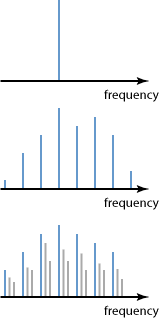Single-mode Operation
Definition: operation of a laser on axial (longitudinal) resonator modes only, or even on a single axial mode
Opposite term: multimode operation
German: einmodiger Betrieb
How to cite the article; suggest additional literature
Author: Dr. Rüdiger Paschotta
The term single-mode operation, which usually applies to lasers, is ambiguous, as it is used with different meanings:
- It can mean single-transverse-mode operation, where a laser operates on a single kind of transverse resonator mode, which is almost always a Gaussian mode (although operation on a single higher-order mode is also possible, e.g. by using some diffractive element in the laser resonator). If operation indeed occurs in a Gaussian mode, the laser's beam quality is diffraction-limited. However, laser oscillation may then still occur on multiple axial (longitudinal) modes, which have essentially the same transverse shape but differing optical frequencies, separated by the free spectral range.

- In other cases, the term really indicates operation on a single resonator mode, which is then also usually an axial (Gaussian) mode. This is more precisely called single-longitudinal-mode operation or single-frequency operation. In that case, the laser is a single-frequency laser, and the laser linewidth is fairly small (→ narrow-linewidth lasers).
The number and type of oscillating resonator modes in a laser depends on the circumstances:
- The excitation of higher-order transverse modes can often be avoided by pumping only the volume covered by the axial modes. This is often done e.g. in end-pumped solid-state lasers.
- Multiple axial modes may still be excited, if the gain bandwidth is larger than the axial mode spacing (as is the case in most solid-state lasers). This may be changed by decreasing the gain bandwidth, by inserting an intracavity filter (e.g. an etalon), or by increasing the axial mode spacing (free spectral range), i.e. by using a very short laser resonator.
Single-frequency operation is usually more difficult to achieve than just single-transverse-mode operation, because it is not sufficient to introduce spatially varying loss or gain. Factors which make it more challenging are all those reducing the mode competition, e.g. inhomogeneous saturation via spatial hole burning.
Questions and Comments from Users
Here you can submit questions and comments. As far as they get accepted by the author, they will appear above this paragraph together with the author’s answer. The author will decide on acceptance based on certain criteria. Essentially, the issue must be of sufficiently broad interest.
Please do not enter personal data here; we would otherwise delete it soon. (See also our privacy declaration.) If you wish to receive personal feedback or consultancy from the author, please contact him e.g. via e-mail.
By submitting the information, you give your consent to the potential publication of your inputs on our website according to our rules. (If you later retract your consent, we will delete those inputs.) As your inputs are first reviewed by the author, they may be published with some delay.
See also: diffraction-limited beams, Gaussian beams, beam quality, single-frequency lasers, single-frequency operation, resonator modes, mode competition, modes of laser operation
and other articles in the category lasers
 |



If you like this page, please share the link with your friends and colleagues, e.g. via social media:
These sharing buttons are implemented in a privacy-friendly way!